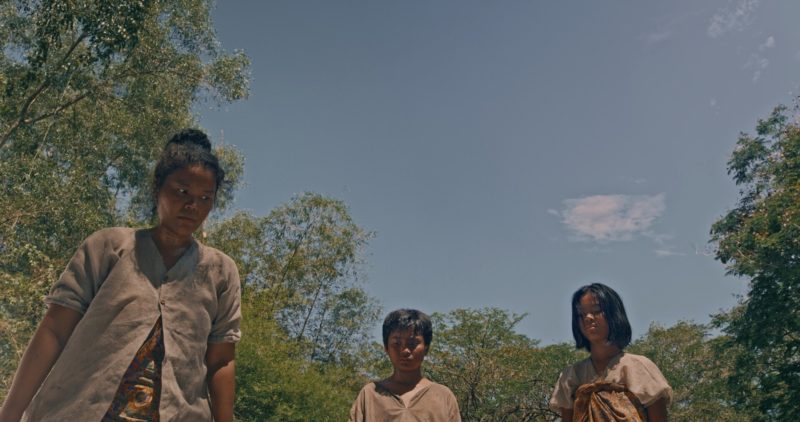
In the forest of the film named Roh, evil comes out at night. But will you recognize this evil when it has the face of a child? As Malaysian filmmaker Emir Ezwan’s first and indie-sized step into feature-length cinema, Roh both enchants and terrifies.
Roh—“soul” in Malay—opens with a young girl (Putri Qaseh) desecrating a shallow grave. Moments later, she appears to the household of the matriarch Mak (Farah Ahmad), her firstborn daughter Along (Mhia Farhana) and youngest son Angah (Harith Haziq) alone, quiet and dirty. They take her in for the night, wholly unaware of the misfortune that is about to come by hosting her. The next morning, the family wakes up to see her, awash in blood with a knife at her own jugular, announcing an omen to them: “When the moon is full… all of you will die.” Mak had warned her children, “Don’t trust the forest,” and because of that any good deed here will come with punishment. Roh can be read as a cautionary tale, but perhaps it’s more apt to see it as a showcase of the existence of evil. No bells and whistles, just a grim fact.
Some horror fans might say Roh is too ephemeral and too simple. But these registers are what make the film and Ezwan’s methods of conjuring fear refreshing. This is horror without rationalization, and for the most part, without modern trickery. The story—scripted by the director Ezwan, Nazri M. Annuar and Amir Hafizi—establishes its pieces and lets them interact with violent and fiery results. Then the curtain drops. The mysterious elements of Roh stay mysteries.
Lathered with earthen tones by day and pitch black by night, Roh tantalizes under the direction of its cinematographer Saifuddin Musa. If you pause the film at any point, the image will look like it’s taken from times past, from when the majority of the forest had remained unexposed to modernity. Nature, here, is still a terrifying unknown.
Appropriately, the production design is minimal. The forest is the set, and anything staged will work for the terrain rather than the other way around. The presence of civilization is also implied. Mak often mentions “a village across the river,” while a gray-haired visitor will refer to her residence over the hill. But these places remain unsighted. Although the simplicity reveals the film’s severe budgetary constraints, the creators of Roh have used these limitations to their own advantage. In this 82-minute nightmare, Mak’s small hut proves to be the sole sanctuary in the great expanse of the forest. Help is difficult to come by, and any stranger is immediately untrustworthy. There is a hunter named Pemburu (Namron) who seems well-equipped to protect her and her children—but might he carry evil as well? It’s easy to relate to Mak’s need and disorientation in protecting her children and warding off the dead young girl’s curse.
The true horror of Roh is less the devil and more the inevitability of the family’s demise—every move made is a step toward fated tragedy. As the expected conclusion tides in, we feel Mak’s struggle to not fall short as a mother and a protector. She may irrationally blame herself, but how could she guess the workings of the world? There was no way she could have known that nothing of you is yours to keep in this forest.

Nguyên Lê is a writer on films currently based in Houston, Texas. He is a Rotten Tomatoes-approved critic and a member of the critics societies/associations such as Houston, Online and Hollywood. His works can be seen on outlets like FANGORIA, /Film, AwardsWatch and more. You may catch him finding the next good eatery or enjoying amateur photography in his downtime.


